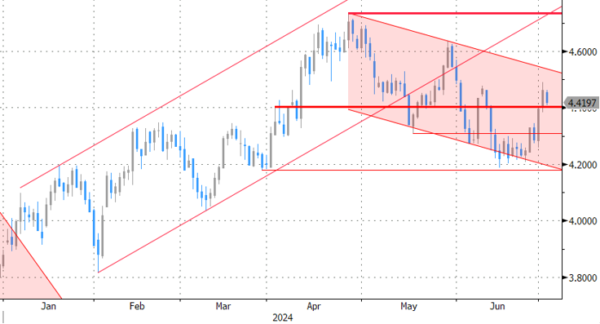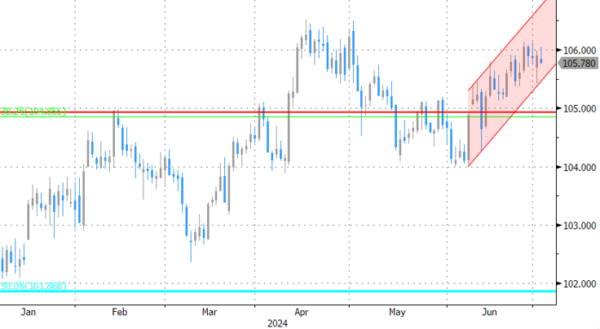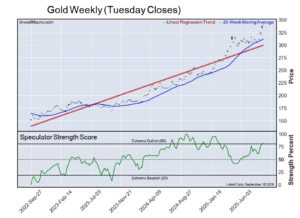Markets
The pace of Eurozone inflation remained steady at 0.2% M/M in June. The outcome was in line with consensus as could be expected following earlier national prints. The Y/Y-figure slowed from 2.8% to 2.5%. Core inflation rose somewhat faster (0.3% M/M), but this was the slowest pace since January (steady Y/Y at 2.9%). Services inflation was more sticky at 0.6% M/M (and 4.1% Y/Y; matching highest level since November 2023). The latter strengthened comments by ECB chief economist Lane this morning who indicated that the June print won’t settle questions the central bank still has on the persistence of (services) inflation: “what we need to see is whether higher services inflation is a backward element and is a legacy of the rapid disinflation or is it a persistent element”. The questions for the July meeting are going to be on the economic side in a clear nod to skipping at least a meeting in further lowering policy rates. Other ECB comments in the sidelines of the ECB forum in Sintra all point in the direction of making monetary policy less restrictive in coming months. ECB Wunsch labels the first two rate cuts as relatively easy as long as inflation hovers around 2.5% because the ECB will still be clearly restrictive then. ECB Muller and Vasle are on the same page. ECB Simkus aligns with markets expectations of two more 25 bps rate cuts this year, in an echo to comments of ECB Rehn last week. ECB Lagarde and Fed chair Powell featured in a panel discussion. In her opening speech, the ECB president yesterday already warned that the inflation battle isn’t over yet. Fed Powell observes a similar stickier services inflation in the US, linked to wages. On the labour market front, he sees it coming off over time as hoped. We believe that the next couple of labour market data (ADP employment change tomorrow and payrolls on Friday) could be key in shaping Fed policy expectations for coming months.
Today’s market story isn’t really vibrant. Core bonds recover some of the recently lost ground in a more risk-averse market setting. Daily changes on the German and US yield curves amount to some -3 to -4 bps. French OAT’s outperform (OAT/swap at 44 bps from intraday high of 48 bps) perhaps linked to news on a significant number of dropouts (front républicain) for next Sunday’s second round of parliamentary elections. The cutoff date is tonight at 6 pm. Key European stock indices lose 0.75% to 1%. EUR/USD after an initial blip trades back near opening levels at 1.0740.
News & Views
Brent oil is testing the upper bound of a short term triangle formation that’s keeping a lid on price action since mid-June. A barrel is currently sold for $87.27, the highest since end April with a combination of supply-side factors supporting prices more recently. One of them includes the rumble in the Middle East. Tensions between Israel and Lebanon-based Hezbollah rose further in the wake of a drone attack last Sunday, causing concerns the initial conflict with Gaza may spread and involve countries including Iran. Another supply-driven boost came from an unusual start of the oil-production disrupting hurricane season. Hurricane Beryl strengthened to the highest category (5). It’s the strongest storm to have ever formed in the Atlantic this time of the year, triggering fears this season could be more severe.
S&P Global warned that countries including the US, France and other major economies, are unlikely to halt the rise in their debt levels in the next several years, Reuters reported based on a publication issued by the rating agency. “We estimate that –for the U.S., Italy, and France– the primary balance would have to improve by more than 2% of GDP cumulatively for their debt to stabilize; this is unlikely to happen over the next three years”, S&P noted. Given the electoral cycle, S&P thinks that only a sharp deterioration of the borrowing conditions could push governments into more forceful budgetary consolidation.
Graphs
Brent crude: supply-related worries push oil prices to highest level since end of April

US 10-yr yield: small correction after fiscal/election-related increase

DXY (trade-weighted dollar): this month’s upward trend channel remains in place despite recent standstill

EUR/GBP: 0.85 a bridge to far going into Thursday’s ballot










